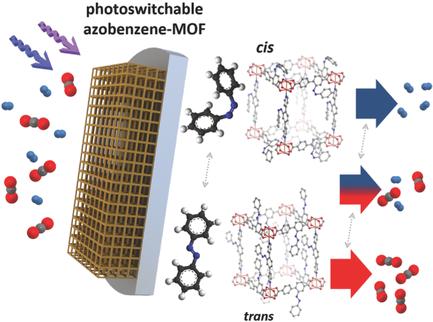当前位置:
X-MOL 学术
›
Macromol. Rapid Commun.
›
论文详情
Our official English website, www.x-mol.net, welcomes your feedback! (Note: you will need to create a separate account there.)
Stimuli‐Responsive Metal‐Organic Frameworks with Photoswitchable Azobenzene Side Groups
Macromolecular Rapid Communications ( IF 4.6 ) Pub Date : 2017-07-31 , DOI: 10.1002/marc.201700239 Anemar Bruno Kanj 1 , Kai Müller 1 , Lars Heinke 1
Macromolecular Rapid Communications ( IF 4.6 ) Pub Date : 2017-07-31 , DOI: 10.1002/marc.201700239 Anemar Bruno Kanj 1 , Kai Müller 1 , Lars Heinke 1
Affiliation

|
Metal‐organic frameworks (MOFs) are nanoporous, crystalline hybrid materials, which enable various functionalities by incorporating functional organic molecules. By using organic linker molecules that possess photoswitchable azobenzene side groups, the remote control over certain properties was introduced to MOFs. Different MOF materials in the form of powders and thin films have been used to demonstrate the photoswitching. The applications of these stimuli‐responsive nanoporous solids range from switching the adsorption capacity of various gases over remote‐controlled release of guest molecules to continuously tunable membrane separation of molecular mixtures. A particular focus of this review is the effect of the azobenzene photoswitching on the host‐guest interaction, enabling smart applications of the material. Steric hindrance, which may suppress the photoswitching in some MOF structures, is also discussed.
中文翻译:

具有光开关性偶氮苯侧基的刺激响应性金属有机骨架
金属有机骨架(MOF)是纳米多孔的晶体杂化材料,通过掺入功能性有机分子可实现各种功能。通过使用具有光开关偶氮苯侧基的有机连接分子,可以将某些特性的远程控制引入MOF。粉末和薄膜形式的不同MOF材料已用于演示光开关。这些刺激响应性纳米多孔固体的应用范围包括:通过客体分子的远程控制释放来切换各种气体的吸附能力,以及连续可调地调节分子混合物的膜分离。本文的重点是偶氮苯光开关对主体-客体相互作用的影响,从而使材料的智能应用成为可能。立体障碍
更新日期:2017-07-31
中文翻译:

具有光开关性偶氮苯侧基的刺激响应性金属有机骨架
金属有机骨架(MOF)是纳米多孔的晶体杂化材料,通过掺入功能性有机分子可实现各种功能。通过使用具有光开关偶氮苯侧基的有机连接分子,可以将某些特性的远程控制引入MOF。粉末和薄膜形式的不同MOF材料已用于演示光开关。这些刺激响应性纳米多孔固体的应用范围包括:通过客体分子的远程控制释放来切换各种气体的吸附能力,以及连续可调地调节分子混合物的膜分离。本文的重点是偶氮苯光开关对主体-客体相互作用的影响,从而使材料的智能应用成为可能。立体障碍



























 京公网安备 11010802027423号
京公网安备 11010802027423号